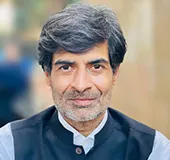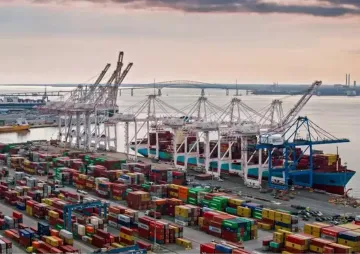
Processes that were once subject to national jurisdictions – be it political conversations, trade and commerce, or national security considerations – are increasingly migrating to ungoverned digital spaces, creating what I have earlier called a “platform planet”. It is clear that the coronavirus will accelerate this process and more permanently fuse our technological and
social systems while encoding inequities and cleavages therein.
Most pertinent to this is the issue of access to digital technologies. Think of the pressure on governments today to deliver governance and services in the age of social distancing, the clamour from parents whose children cannot access educational opportunities, or demands from historically marginalized groups who may not be able to work remotely. Life, protection, and livelihood will all need to be guaranteed virtually and most capitals around the world will struggle to provide these.
Some positive transformations will be driven by technology companies looking to break new ground and compete for consumers among the millions of social and commercial interactions that will now be permanently online. Videoconferencing platforms, for instance, have emerged as the go-to technology keeping governments and businesses running even as social distancing is being practised. And still more change will be driven by governments adopting digital tools to carry out health surveillance measures or to enforce quarantines. Evolving debates and assumptions on user agency, privacy and data protection may be significantly altered in the year ahead.
Undoubtedly, the most important structural change will be in the form and format of the relationship between technology and society. Over the past two decades, there have been two fundamental notions that have shaped this ever-evolving relationship. The first, roughly corresponding to the first decade of the 21st century, was a near universal belief in the emancipatory potential of emerging technologies and a social willingness to accept new technologically induced disruptions. The second perspective, corresponding to the second decade, was the antithesis of the first – a “tech-lash” or scepticism about the role of emerging technologies in our social lives and a growing degree of suspicion about the intent and actions of “big tech” and “strong states”.
The coronavirus outbreak will demand a synthesis of these, and other, perspectives under extraordinarily compressed timelines. The many decisions that will be made over the coming year will either become entrenched or will reinforce certain pathways in the decade ahead. Technologies that society would have once expected greater regulatory scrutiny around –such as the use of artificial intelligence (AI) in healthcare – will likely be fasttracked and deployed. Meanwhile, consumer technologies that are scaling rapidly, such as videoconferencing and fintech platforms, will face additional scrutiny from consumers and states as they become more utility-like in their deployment.
Technologies that society would have once expected greater regulatory scrutiny around –such as the use of artificial intelligence (AI) in healthcare – will likely be fast-tracked and deployed.
As this process of synthesis unfolds over the coming year, the international community will be confronted with a new set of opportunities as well as risks. Perhaps the first and most visible risk emanates from a largely ungoverned digital public sphere. Indeed, this pandemic has also been accompanied by an “infodemic”, with misinformation and disinformation flooding most social media platforms, which for all practical purposes play the role of both traditional media and discussions rooms of yore that shaped public opinion.
Fake news alone, however, is not the only dimension of this risk. The response to it may be equally dangerous. The COVID-19 outbreak may end up creating stronger censorship regimes in an attempt to curb the spread of disinformation. Equally worrying is the power of technology platforms to mediate these spaces during times of crisis and the dangerous collaboration or confrontation brewing between technology companies and governments. For instance, certain technology platforms took down content by President Jair Bolsonaro of Brazil because they deemed it spread disinformation. But should platforms have the ability to censor the content of a head of state? On the other hand, should they partner with governments and dilute freedom of expression through new measures that may outlast this pandemic?
A second related risk is the data-sharing practices that technology companies, health institutions and governments are adopting – with little oversight or accountability – to combat COVID-19. This trend will not only be about the data generated today. Instead, the COVID-19 pandemic will likely create a new battlefield, one that will be defined by the datasets generated by the fusion of our biological and digital worlds. Indeed, one set of technologies that were already being deployed rapidly before the virus outbreak were those related to genomics. The practices around genetic privacy – and the institutions that manage them – in the year ahead may well create new and unexpected risks to our fundamental rights as unique living beings.
A third risk likely to challenge our technological futures are efforts to undermine the integrity of the cyber realm. While most nations remain worried about threats to critical infrastructure (the United Nations has already called for a digital ceasefire) the COVID-19 outbreak will also exacerbate “petty” cyber-crimes. These are minor cyber incidences; those that may not pose systemic national security threats but will affect the financial and social lives of individuals dramatically. The sudden uptick in COVID-related phishing scams, telemedicine scams and attacks on medical institutions all point in this direction. Trust in technology will be undermined at a time when the digital is the ether for globalization to survive.
The fourth risk is of individuals being permanently left behind as the process of digitalization continues to accelerate. Inequality has been the defining political zeitgeist of our generation – one that digital technologies have often accentuated. In countries without full or robust access to the internet, citizens are suffering from multidimensional socio-economic challenges as the pandemic snatches away their access to essential public goods.
But the challenge goes beyond this. Just as individuals are beginning to learn that not all work requires formal office spaces, businesses may well realize that not all operations require humans. The rapid adoption of AI and robotics energized amid the pandemic could accelerate a process that governments and policy-makers have been concerned about for years – technology-induced unemployment.
The final risk could end up being a product of how states actually respond to these various challenges amid a rapidly digitizing global society. No two societies are the same – they are defined by different political values, social practices and economic priorities. With COVID-19 forcing more of our social lives, business operations and governance online, the race to infuse the global digital world with a particular set of values and technological standards will only accelerate. Digital “code wars” may well be this century’s ideological confrontation that may partition the world in the end.
Think of the UN, the centrepiece of the liberal international order, partnering with Tencent, the digital champion of a vast surveillance state, to conduct its remote work operations. This has become a cause for concern for many countries. Reports indicate that the UN is already backtracking from its decision under pressure from human rights groups and democratic nations. Indeed, the varied digital societies that are emerging may fuel loud “geotechnological” competition.
That said, policy-makers may also see in the COVID-19 crisis an opportunity to reform political and administrative practices that were earlier hobbled by legacy institutional constraints. The most obvious, perhaps, is the accelerated adoption of what the UN calls “digital public goods”. These are the common digital “railroads”, which act as force multipliers for a range of business and governance operations.
For instance, India’s Digital ID system has helped the country navigate the pandemic by ensuring cash transfers and digital payments for a range of essential goods. The demand for similar architectures has been growing around the world. Singapore had already signed an MoU with the Indian government, even before the virus outbreak, to develop such a system. Similarly, Google has cited India’s digital payments infrastructure to call on the Federal Reserve to enable similar innovations in the US. These trends could see universal strengthening at this time.
This moment offers an opportunity for states to respond to the needs of a growing global informal workforce. The informal labour force and the “gig economy” workforce need new systems of social protection. The absence of this has placed them at great risk and at the frontline of this pandemic. These political reforms may not be ignored much longer. The idea of a universal basic income – a measure that is supported both by the Pope and The Financial Times – could also find favour and catalyse a new dimension for the future of work.
Perhaps the most significant opportunity will be for states and individuals to realize the potential of a truly global digital society. Responding to COVID-19 has compelled governments and communities to share sporadic information, some best practices and critical technologies rapidly. Consider for, instance, a rapidly growing community of entrepreneurs sharing opensource 3D printing designs for ventilators. Perhaps civil society organizations and policymakers can use the COVID-19 moment to push for new pipelines that will enable the transfer of technologies and innovations and encourage them to rethink rigid intellectual property regimes, which hindered this earlier.
Perhaps the most significant opportunity will be for states and individuals to realize the potential of a truly global digital society. Responding to COVID-19 has compelled governments and communities to share sporadic information, some best practices and critical technologies rapidly
Over a century ago, when individuals were isolating themselves amidst a far deadlier Spanish Flu, many (primarily Americans) turned to the telephone to stay in touch with friends, family and colleagues. Of course, it was a nascent technology at the time and services promptly broke down because of the rapid rise in demand. But rather than crippling the industry and the technology forever, the Spanish Flu only served to underscore how essential it was to modern society. Over a century later, it is clear that the telephone was instrumental in shaping our global village.
We are at a similar junction today. And decades later, historians may well scrutinize the decisions made in the year ahead when studying how the digital shaped individuals, communities, nations and the world they inherited.
This essay originally appeared in World Economic Forum.
The views expressed above belong to the author(s). ORF research and analyses now available on Telegram! Click here to access our curated content — blogs, longforms and interviews.




 PREV
PREV


